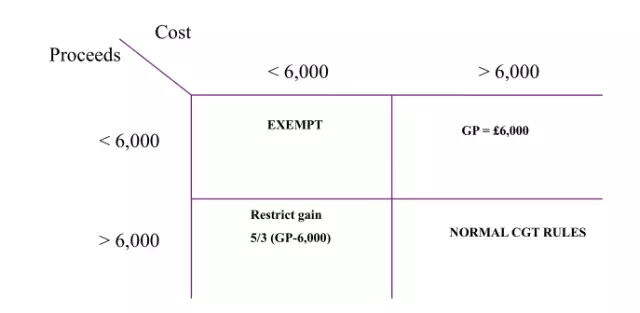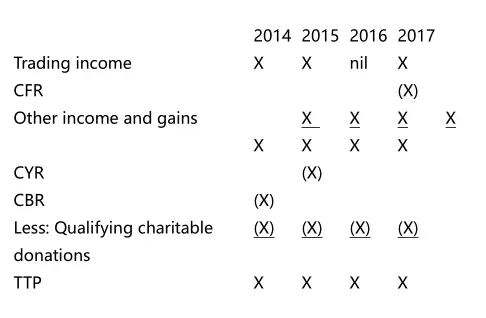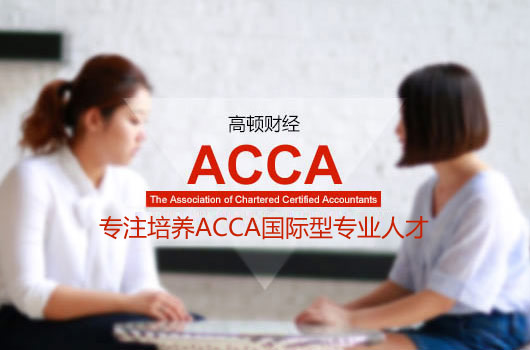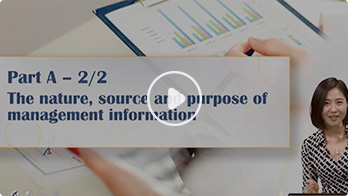迎战2017年6月份ACCA考试,你准备好了吗?
ACCA F6的公式更新出炉啦~
Sdanvi老师为大家操碎了心...
火速整理最全ACCA F6公式!
让你的ACCA冲刺阶段,火力全开!


Income Tax Liability
1.Adjusted net income=net income-gross PPS-gross gift aid donation
2.Personal allowance
Std PA=£11,000
When'Adjusted net income'≥£100,000
Std PA 11000
Less:restriction(adjusted net income-100000)*1/2
Adjusted PA
'Adjusted net income'≥£122000,PA=0
3.Gift aid donation
•Gross up=net gift aid donation*100/80
•Extending the rate band
32000(150000)+gross gift aid donation
•Adjusted net income=net income-gross gift aid donation
4.Child benefit income tax charge:
When£60,000≥'Adjusted net income'≥£50,000
%=(Adjusted net income-50000)/100 Round down
child benefit income tax charge=%*child benefit received
5.Authorized mileage allowances
2.Personal allowance
Std PA=£11,000
When'Adjusted net income'≥£100,000
Std PA 11000
Less:restriction(adjusted net income-100000)*1/2
Adjusted PA
'Adjusted net income'≥£122000,PA=0
3.Gift aid donation
•Gross up=net gift aid donation*100/80
•Extending the rate band
32000(150000)+gross gift aid donation
•Adjusted net income=net income-gross gift aid donation
4.Child benefit income tax charge:
When£60,000≥'Adjusted net income'≥£50,000
%=(Adjusted net income-50000)/100 Round down
child benefit income tax charge=%*child benefit received
5.Authorized mileage allowances
Up to 10,000 miles 45p
over 10,000 miles 25p
6.Additional charge of living accommodation benefit
6.Additional charge of living accommodation benefit
Additional benefit=(cost of providing accommodation–£75,000)×the official rate of interest
which is time apportionment
7.Benefit of use of assets
7.Benefit of use of assets
The benefit assessed is the higher of
-20%x(MV when first provided–the price paid by employee)
-rental paid by employer(if asset is rented)
which is time apportionment
8.Benefit of gift of assets
8.Benefit of gift of assets
If new asset is given:cost of the asset
If used assets is given:higher of
-(MV when given–the price paid by employee)
-(MV when first provided–benefits already assessed–the price paid by employee)
9.Benefit of provision of a car
9.Benefit of provision of a car
Taxable car benefit=X%*(list price–capital contribution)*time proportion–payment by employee for use of the car
Emission≤50 g/km,X=7%
Emission≤50 g/km,X=7%
51≤Emission≤75 g/km,X=11%
76≤Emission≤94g/km,X=15%
Emission=95g/km,X=16%
Emission>95g/km,increase by 1%for every 5 g/km increase
X=(Emission-95)/5 Round down
diesel cars:+3%
Maximum:37%
10.Benefit of Provision of fuel
10.Benefit of Provision of fuel
X%*£22,200 which is timeapportionment
11.Provision of vans
11.Provision of vans
Standard benefit of£3,170
£598 a year for private fuelwhich is time apportionment
12.PPS
12.PPS
Grossup=net PPS*100/80
Extending the rate band
32000(150000)+gross PPS
Adjusted net income=Netincome-gross PPS
13.OPS
13.OPS
Employer’scontributions:trading profit-OPS
Employee’scontributions:employment income-OPS
14.Furniture replacement relief
14.Furniture replacement relief
Furniturereplacement relief=MV of new furniture(same function)-resale value of oldfurniture
15.Rent a room
15.Rent a room
Gross rental income<=£7500,lower of
-Property business income=0
-Property business income=normal calculation=gross rent–expenses–Furniture replacement relief
Gross rental income>£7500,lower of
-Property business income=normal calculation or,
-Property business income=alternative calculation=gross rent-7500
16.Premium
16.Premium
Landlord:
Premium is treated asproperty business income for the year of grant.
P-P×2%(n-1)
Where:P=total premium
n=duration of lease in years
Tenant:premium paid is treated as a tradingexpense(proportioned to mont
| P-P×2%(n-1) * | m |
| n | 12 |
17.Class 1 NIC(on cashearnings)
Primary:
£1-£8,060per year Nil
£8,061-£43,000per year 12%
£43,001 and above per year 2%
Secondary:
£1-£8,112per year Nil
£8,113and above per year 13.8%
18.Class 1A NIC(on taxablebenefits)
18.Class 1A NIC(on taxablebenefits)
=taxablebenefits*13.8%
19.Class 2
19.Class 2
=£2.8*weeks
20.Class 4(on trading profit:which is after loss relief)
20.Class 4(on trading profit:which is after loss relief)
£1-£8,060per year Nil
£8,061-£43,000per year 9%
£43,001 and above per year 2%
21.Payment of tax
21.Payment of tax
for 16/17:
-31.1.17-first payment onaccount=1/2*(15/16 income tax payable+15/16 NIC Class 4)
-31.7.17-second payment onaccount=1/2*(15/16 income tax payable+15/16 NIC Class 4)
-31.1.18-final balancing payment=16/17 income tax payable+16/17 NIC Class 4 tax-(15/16income tax payable+15/16 NIC Class 4)+16/17CGT+16/17 Class 2
Payment ofcapital gain tax:31.1.18for 16/17
Payment ofClass 2:31.1.18for 16/17
22.Interest on late payment of tax:3%*due amount(which is time apportionment)
22.Interest on late payment of tax:3%*due amount(which is time apportionment)
POAs-runs from 31.1.2017/31.7.2017
Final payment-runs from 31.1.2018
23.Penaltyon late balancing payment:
23.Penaltyon late balancing payment:
-no more than 1 month,0
-no more than 6 month,5%,(5%*(shouldpay-actual pay))
-more than 6 months,10
-more than 12 months,15%
24.Penaltiesfor late return:
24.Penaltiesfor late return:
-thereturn filed after the filing date,100
-morethan 3 months,10 per day,at most 90 days
-morethan 6 months,higher of 5%*tax due on return&300
-morethan 12 months,higher of 100%/70%/5%*tax due on return&300
CGT
1.Transfers between spouses/civil partner(A→B)
A:
A:
less:cost
deemed proceeds:
less:rollover relief
Gain taxed now(0)
B:
base cost=deemed proceeds-rollover relief
2.Partial disposal
2.Partial disposal
| Proceeds | A |
| Less:selling costs | (X) |
| X | |
| Less: | |
| original cost*A/(A+B) | (X) |
| Chargable gain | X |
A–MV of the part disposed of
B–MV of the remaining part of the asset
3.Damaged asset
3.Damaged asset
A
A+B
A=compensation received
B=unrestored value of asset
4.Destroyed assets
4.Destroyed assets
Compensation received
Less:cost
Less:rollover relief
Gain taxed now(not reinvest)
Base cost of the new asset=MV of the new asset-rollover relief
5.Non wasting chattels(antiques and paintings)
5.Non wasting chattels(antiques and paintings)

6.Wasting assets(copyright)
Remaining cost is the key part in the computation
For example,if a taxpayer acquires a wasting asset with a remaining life of 40 years and disposes of it after 15 years,so that 25 years of useful life remain,only 25/40 of the cost is deducted in the computation.
7.Principal private residence
7.Principal private residence
PPR relief is calculated as
Gain*period of occupation/period of ownership
The letting relief is the lowest of
The gain arising in the letting period not covered by PPR relief
£40,000
The PPR relief already given
8.Valuing quoted shares
8.Valuing quoted shares
lower of:
the‘quarter-up’value:lower quoted price+1/2×(higher quoted price–lower quoted price)
the average of the highest and lowest marked bargains(ignoring bargains marked at special prices)
9.Cost of shares(matching rules)
9.Cost of shares(matching rules)
Acquisitions on the same day
Acquisition in the next 30 days–FIFO basis
Shares in the share pool
Proforma of share pool
| Share pool | NO. | Cost |
| Additions | X | X |
| Disposals | (X) | X |
| X | (X) |
10.Takeover
| Proceeds(cash received) | A |
| Less: | |
| original cost*A/(A+B) | (C) |
| Chargable gain | X |
where:
A=cash element and;
B=value of non cash element i.e market value at date of takeover
11.Gift relief
11.Gift relief
Assets qualifying:
Business assets
Unquoted shares in a trading company
Quoted shares in a personal trading company(>5%)
A:
Deemed proceeds:
less:cost
less:gift relief
Gain taxed now(actual gain)
B:
base cost=deemed proceeds-gift relief
If the company has chargeable non-business assets at the time of the gift
gift relief will be:
Total gain×MV of CBA/MV of CA
CBA=chargeable business assets(chargeable assets except investments)
CA=chargeable assets(assets not exempt from CGT)
12.Replacement of Business Assets
12.Replacement of Business Assets
Proceeds of old asset
Less:cost
Less:rollover relief
Gain taxed now(not reinvest)
Base cost of the new asset=MV of the new asset-rollover relief
Corporation tax liability
1.Proforma

2.Computing the corporation tax liability

2.Computing the corporation tax liability
Corporation tax payable is calculated as:
TTP*CT rate for the financial year
4.Chargeable Gains for Companies
4.Chargeable Gains for Companies
proceeds:
less:incidental cost on disposal
net proceeds
less:cost
capital exp.(enhancement cost)
gain
less:
indexation allowance on cost
cost*(RPI卖-RPI买)/RPI买
indexation allowance on enhancement cost
enhancement cost*(RPI卖-RPI提)/RPI提
indexed gain
5.Matching rules for shares-companies:
5.Matching rules for shares-companies:
same day
9 days prior to disposal
FA1985 pool:from 82.4.1 to 10 days prior to disposal(IA should be considered)
6.Trading losses
6.Trading losses

7.Self-assessment and payment of tax by large companies
Installments are based on expected current year’s liability.
The four quarterly installments will be made in months 7,10,13 and 16 following the start of the accounting period.The installments are due on the 14th of the month.
If an accounting period is less than 12 months
Each installment=3×CT/n(n=no.of months in AP).
Final installment always due by 14th of the 4th month following end of accounting period.
Inheritance tax
1.lifetime tax(1)CLT(donee pays tax)
donee pays tax
step1:7 yrs accumulation of other CLTs(tranfer date转让日往前7年内)
step2:nil rate band available(nil rate band at transfer year-7 yrs accumulation)
step3:value of CLT(after exemptions)
step4:calculate the IHT using 0%/20%
(2)CLT(donor pays tax)
donor pays tax
step1:7 yrs accumulation of other CLTs(tranfer date转让日往前7年内)
step2:nil rate band available(nil rate band at transfer year-7 yrs accumulation)
step3:net value of CLT(after exemptions)
step4:calculate the IHT using 0%/25%
step5:gross value of transfer(net value of transfer+IHT paid by donor)
2.Death tax on Lifetime transfer if the donor dies within 7 yrs of making a PET/CLT,then the PET&CLT will need to calculate an additional death tax.
step1:7 yrs accumulation of PETs and gross value of CLTs if donor pay the lifetime tax(transfer date转让日往前7年内)
step2:nil rate band available(325000 death year nil rate band-7 yrs accumulation)
step3:Gross value of CLT/PET
step4:calculate the IHT using 0%/40%
step5:reduce the taper relief(if available)
step6:deduct any lifetime tax already paid
6.Death tax on death estate
step1:7 yrs accumulation of PETs and gross value of CLTs if donor pay the lifetime tax(death date往前7年内)
step2:nil rate band available(325000 death year nil rate band-7 yrs accumulation)
step3:value of death estate
step4:calculate the IHT using 0%/40%
7.Value of death estate Value of death estate:ALL ASSETS
except for:
mortgaged asset(endowment mortgage is not deducted)
legally enforceable debts(verbally promised is not deducted)
funeral expense
spouse exemption
Value added tax
1.VAT=VAT exclusive amount×20%2.VAT=VAT inclusive amount×20/120
3.VAT inclusive amount=VAT exclusive amount×120/100
4.Cash discount
Output VAT=sales revenue*(1-x%discount)*20%
Adjustment is made if discount subsequently does not apply.
5.VAT on fuel the company only paid the business part:
input VAT=business fuel*20%
the company paid all fuel(business&private),however employee reimburse all the private fuel
input VAT=full amount*20%,output VAT=private fuel*20%
the company paid all fuel(business&private),and employee does reimburse all the private fuel:
input VAT=full amount*20%,output VAT=Scale charge*20%
6.Flat rate scheme
flat rate percentage*tax inclusive income(std+zero+exempt supplies).
ACCA题库,戳:ACCA题库【手机可刷+全球题库】(按照知识点进行分类配题,有知识点没有搞懂,无法解锁,直至掌握,目前阶段免费)
声明丨本文由中国ACCA考试网整理发布,经Sdanvi老师许可,微信公众号“ACCA学习帮”授权,未经原作者许可和原出处授权不得随意转载引用,如有侵权将依法追究责任。




 考经分享
考经分享
 发布时间:2019-10-28
发布时间:2019-10-28 

 复制本文链接
复制本文链接 模拟题库
模拟题库

 105
105

















